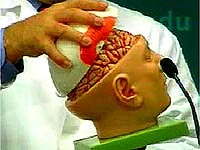
Pular antidepressants boost brain growth, Hopkins scientists report
Discovery in rodents may explain why some antidepressants require weeks of use before they work
The beneficial effects of a widely used class of antidepressants might be the result of increased nerve-fiber growth in key parts of the brain, according to a Johns Hopkins study being published in the January 2006 issue of the Journal of Neurochemistry.
The study on rats, led by Vassilis E. Koliatsos, M.D., a neuropathologist at the Johns Hopkins University School of Medicine, found that selective serotonin reuptake inhibitors (SSRIs) increase the density of nerve-impulse-carrying axons in the frontal and parietal lobes of the neocortex and part of the limbic brain which control the sense of smell, emotions, motivation, and organs that work reflexively such as the heart, intestines and stomach. "It appears that SSRI antidepressants rewire areas of the brain that are important for thinking and feeling, as well as operating the autonomic nervous system," said Koliatsos.
Axons are long, filament-shaped extensions of neurons that, together with myelin, are the main constituents of nerves. Axons conduct chemically driven nerve impulses away from the cell body toward a narrow gap known as a synapse. Among the chemicals involved are such monoamines as norepinephrine and serotonin, which, at the synapse, are transferred to another neuron.
Antidepressants, such as Prozac, Zoloft and Paxil, have long been thought to exert their clinical effects by increasing synaptic concentrations of serotonin and norepinephrine, enhancing or stimulating their transference.
"But our findings -- that serotonin reuptake modulators increase the density of nerve synapses, especially in the front part of the brain - may offer a better explanation of why antidepressants are effective and why they take time to work," according to Koliatsos.
For example, antidepressants increase synaptic monoamines within hours, and the regulatory effects on receptors are complete within a few days, yet clinically meaningful results from antidepressants usually require a two- to four-week delay.
"This disparity between simple pharmacological effects and clinical experience might be due to the time it takes for serotonin axons to grow," Koliatsos said.
"For the patient, this hypothesis provides more tangible evidence of a real effect in the brain," he added.
In the Hopkins study, Koliatsos and his team gave either the selective serotonin reuptake inhibitor fluoxetine (Prozac), the selective serotonin reuptake enhancer tianeptine (a drug approved only for human use in France) or the selective norepineprine reuptake inhibitor desipramine, a so-called tricyclic antidepressant, to groups of rats for four weeks and studied anatomical patterns of serotonin stimulation on various parts of the brain. The results showed that fluoxetine and tianeptine, but not desipramine, increased the density of serotonin axons in the frontal and parietal neocortex and certain limbic cortical and subcortical areas.
One possible explanation for this action is the brain-derived growth factor (BDNF). BDNF is regulated by levels of serotonin and is known to be a prime candidate for causing serotonin axon growth, Koliatsos said.
In general, the relationships between brain serotonin concentrations and BDNF expression are very complex, but previous studies have suggested that both higher (such as caused by serotonin reuptake inhibitors) and lower (such as effected by tianeptine) concentrations of free serotonin might induce BDNF expression in such brain regions as the frontal and parietal cortex.
The researchers caution that since a previous study failed to show a correlation between tianeptine treatment and BDNF levels, further investigation of the complex regulations of BDNF by antidepressants is needed.
###
Funding for this study came from the National Institute of Mental Health.
The study is currently available at the Journal of Neurochemistry Web site:
http://www.blackwellpublishing.com/journal.asp?ref=0022-3042
*New RSS Feed available from Johns Hopkins Medicine:
http://www.hopkinsmedicine.org/mediaII/RSSinstructions.html
EurekAlert! Public release date: 19-Dec-2005
Contact: Eric Vohr
evohr1@jhmi.edu
410-955-8665
Johns Hopkins Medical Institutions
# posted by Unknown : 10:03 AM


 Oz
Oz
Originally uploaded by GFR.
# posted by Unknown : 10:51 AM


3 men grew pot in cave, D.A. says
Authorities say operation could grow 100 pounds every 8 weeks
By LEON ALLIGOOD, Dickson Herald, 12/18/05
HARTSVILLE, Tenn. — Investigators from the 15th Judicial District Drug Task Force found a mother lode of marijuana in the unlikeliest of places — a cave.
Beneath a stylish A-frame home on Dixon Springs Road in eastern Trousdale County, three men allegedly set up a sophisticated operation to grow as much as 100 pounds of marijuana every eight weeks.
"It's pretty amazing what they had under there — water for irrigation, special lighting, devices to keep the humidity just right. These guys were professionals. They knew what they were doing," said District Attorney General Tommy Thompson of Hartsville.
"They could grow in 60 days what it would take four and a half months to grow outside."
Arrested on Wednesday were Brian Gibson and Greg Compton, while a third man, Fred Strunk, was arrested near Gainesville, Fla. All three are in jail, with Gibson and Compton being held in the Trousdale County Jail. Bail was set for Gibson and Compton at $5 million, while Strunk's was set at $15 million, Thompson said. Local authorities were in Florida yesterday to return Strunk to Tennessee.
According to the district attorney general, the investigation into the operation began about five years ago when a home was built above the cave, but it never appeared anyone lived there.
"The front of the cave used to be a hole that you'd crawl into, and it opened up into a pretty big room that was 20-feet high. They cut the side of the hill so you could just drive right into the cave,'' Thompson said.
The cave, reached from the house via secret entrances, is said to be about two miles long, but the marijuana operation was located about 100 yards inside. Thompson said the other end of the cave had been blocked to keep trespassers out.
According to the prosecutor, the men told locals they were going to be mining statuary rock.
In another suspicious incident, the local electric company was asked to install a larger transformer than usually required by a residence. But apparently that was not enough electrical power to operate the grow lamps required to raise 800 marijuana plants at a time. Instead of asking the electric company for more power, the men spliced into the Tri-County Electric line and were stealing electricity, Thompson said.
"They had the operation set up so that one person could operate it during the growing season,'' he noted.
To harvest the illegal crop, Thompson said the men would hire a half-dozen Hispanic workers in Arizona and drive them to Tennessee. For part of the journey the windows on the van would be covered so the workers did not know where they were.
"They would drive right into the cave and let them out to begin working,'' the prosecutor said.
"As for distributing it, we're sure that some of it went to Nashville and other locations in the area."
There could be more arrests, but Thompson said he believes the ringleaders of the operation have already been nabbed.
"It's just unbelievable what they've done. It's like something out of a James Bond movie."
District Attorney General Tommy Thompson
Leon Alligood can be reached at 259-8279 or at lalligood@tennessean.com.
Copyright © 2005, tennessean.com. All rights reserved.
# posted by Unknown : 10:21 AM



